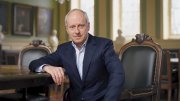With devilish timing, The New York Times home page published “…Harvard Is the Stanford of the East” at 1:19 p.m. last May 29, between the Commencement morning and afternoon exercises. It cited Stanford’s new eminence using “measures that Harvard once dominated”: undergraduate admissions yield, student picks of a “dream college,” fundraising prowess. Clarification posted 8-29-2014: Harvard points out that its yield among admitted applicants still exceeds Stanford's (82 percent vs. 79 percent); given a surge in applications to Stanford, that institution's rate of undergraduate admissions now hovers around 5 percent, vs. 5.9 percent for the Harvard College class of 2018.
In an Internet era, Stanford is in a sweet spot. One-quarter of its undergraduates earn computer-science or engineering degrees, the Times reported. Its president has thrived in that field (and serves on the Google and Cisco boards). There is the siren song of Silicon Valley—center of perhaps the greatest wealth-creation in history. People prefer the climate, earthquakes notwithstanding.
That said, Stanford—more than Harvard and other institutions—suffers from a divide between “techies” and “fuzzies” (humanities students). And the world may become oversaturated with apps.
Cambridge and Palo Alto are not a competitive duopoly. But Harvard administrators do seem to have Stanford in mind. “Innovation” is constantly invoked—and backed tangibly by the iLab and recurrent grant competitions underwritten by the University. Venture capitalist James Breyer (a Stanford undergraduate with a Harvard M.B.A. and deep ties to technology and new media) has been elected to the Corporation. The marquee capital-campaign priority is engineering and applied sciences.
Senior officials also bemoan the perception that Harvard, rooted in the Northeast, is “old and cold.” Perhaps partly in response to surveys showing that Harvard students are less happy about their experiences than those elsewhere (including Stanford), resources have flowed into “common spaces”: the Yard’s colorful chairs, the Science Center Plaza (which has yet to attain the status of Stanford’s White Plaza as a crossroads for student life).
Introducing Drew Faust on May 29, Harvard Alumni Association leader Kate Gellert said, “Harvard’s twenty-first president, Charles W. Eliot, in his inaugural address, 145 years ago, said, ‘The inertia of a massive university is formidable. A good past is positively dangerous if it makes us content with the present and thus unprepared for the future.’”
Harvard is not mired in inertia. Its leaders are pursuing improvements in pedagogy, research, and the student experience. As it builds applied-science expertise, it maintains strengths in the search for meaning and value—one of Faust’s themes, and more important long term than an app for scoring the best local taco. Stanford nonetheless has real momentum, winning students and recruiting professors. Is Harvard (still) cool? Sure. But Stanford is hot.







